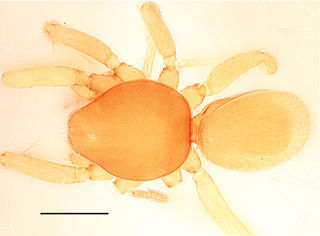
The cephalothorax, also called prosoma in some groups, is a tagma of various arthropods, comprising the head and the thorax fused together, as distinct from the abdomen behind. The word cephalothorax is derived from the Greek words for head and thorax. This fusion of the head and thorax is seen in chelicerates and crustaceans; in other groups, such as the Hexapoda, the head remains free of the thorax. In horseshoe crabs and many crustaceans, a hard shell called the carapace covers the cephalothorax.
Colima is a genus of spiders in the family Zodariidae, found in the state of Colima, Mexico.

Rugathodes sexpunctatus is a minute species of spider in the family Theridiidae, the cobweb or tangle-web spiders. This family includes the medically important genus Latrodectus—the widow spiders. The species in the genus Rugathodes are too small to be dangerous to humans. Very little is known about most species in this genus.

Bannana is a genus of goblin spiders native to Xishuangbanna prefecture, Yunnan Province, China, where it lives in the leaf-litter of tropical rainforest. There are two known species: Bannana crassispina and B. parvula, both described in 2015. Individuals are pale yellow and unpatterned, and range from around 1.0 to 1.8 mm in body length, with females being slightly larger than males. The eyes are reduced or entirely absent. Known only from a nature reserve in Xishuangbanna, Bannana belongs to a group of Asian goblin spiders known as the "Dysderoides complex", that ranges from China to Pakistan and south to Indonesia.

Cryphoeca silvicola is a small species of dwarf sheet spider in the family Cybaeidae which has a Palearctic distribution. The generic name, Cryphoeca, means hidden and the specific name silvicola means "living in the woods".
Carpathonesticus avrigensis is a species of araneomorph spider of the family Nesticidae. It occurs in Romania, where it was discovered in a cave. Only two specimens, a male and a female, are known.
Carpathonesticus caucasicus is a species of araneomorph spider of the family Nesticidae. It occurs in Georgia, where it is found in caves.
Carpathonesticus fodinarum is a species of araneomorph spider of the family Nesticidae. It occurs in Romania, where it occurs in caves.
Carpathonesticus ljovuschkini is a species of araneomorph spider of the family Nesticidae. It occurs in the Russian Caucasus. No male specimens have yet been described.
Carpathonesticus lotriensis is an araneomorph spider species of the family Nesticidae. It occurs in Romania, where it can be found in caves.
Carpathonesticus mamajevae is an araneomorph spider species of the family Nesticidae. It occurs in Georgia, in the Lagodekhi Nature Reserve.
Domitius menozzii is an araneomorph spider species of the family Nesticidae. It occurs in Italy, where it can be found in caves. It was described by Ludovico di Caporiacco in 1934.
Carpathonesticus paraavrigensis is a species of araneomorph spider of the family Nesticidae. It occurs in Romania, where it was discovered in a narrow gorge, on the overhanging side.
Carpathonesticus puteorum is a species of araneomorph spider of the family Nesticidae. It is found in the Romanian caves at an altitude of 460 to 930 m.
Carpathonesticus parvus is a species of araneomorph spider of the family Nesticidae. It occurs in Bosnia-Hercegovina, where it is found in caves. It was originally described from a single female specimen.
Carpathonesticus racovitzai is an araneomorph spider species of the family Nesticidae. It occurs in Romania, where it can be found both in caves and outdoors. It was transferred from the genus Nesticus to Carpathonesticus in 1982 by Weiss and Heimer.
Carpathonesticus simoni is an araneomorph spider species of the family Nesticidae. It occurs in Romania, where it can be found in caves. It was transferred from the genus Nesticus to Carpathonesticus in 1980 by Lehtinen and Saaristo.
Carpathonesticus spelaeus is an araneomorph spider species of the family Nesticidae. It occurs in Romania, where it can be found in caves and outdoors under calcareous blocks. It was transferred from the genus Nesticus to Carpathonesticus in 1980 by Lehtinen and Saaristo.
Carpathonesticus zaitzevi is an araneomorph spider species of the family Nesticidae that occurs in Georgia. It was transferred from the genus Nesticus to Carpathonesticus in 1996.
Chrysilla guineensis is a species of jumping spider. It is endemic to Guinea. It was described in 2013 based on specimens collected from the Nimba Mountains.



